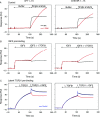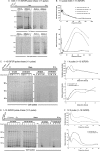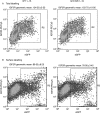Structure and function of the human Gly1619Arg polymorphism of M6P/IGF2R domain 11 implicated in IGF2 dependent growth
- PMID: 19208780
- PMCID: PMC2659294
- DOI: 10.1677/JME-08-0154
Structure and function of the human Gly1619Arg polymorphism of M6P/IGF2R domain 11 implicated in IGF2 dependent growth
Abstract
The mannose 6-phosphate/IGF 2 receptor (IGF2R) is comprised of 15 extra-cellular domains that bind IGF2 and mannose 6-phosphate ligands. IGF2R transports ligands from the Golgi to the pre-lysosomal compartment and thereafter to and from the cell surface. IGF2R regulates growth, placental development, tumour suppression and signalling. The ligand IGF2 is implicated in the growth phenotype, where IGF2R normally limits bioavailability, such that loss and gain of IGF2R results in increased and reduced growth respectively. The IGF2R exon 34 (5002A>G) polymorphism (rs629849) of the IGF2 specific binding domain has been correlated with impaired childhood growth (A/A homozygotes). We evaluated the function of the Gly1619Arg non-synonymous amino acid modification of domain 11. NMR and X-ray crystallography structures located 1619 remote from the ligand binding region of domain 11. Arg1619 was located close to the fibronectin type II (FnII) domain of domain 13, previously implicated as a modifier of IGF2 ligand binding through indirect interaction with the AB loop of the binding cleft. However, comparison of binding kinetics of IGF2R, Gly1619 and Arg1619 to either IGF2 or mannose 6-phosphate revealed no differences in 'on' and 'off' rates. Quantitative PCR, (35)S pulse chase and flow cytometry failed to demonstrate altered gene expression, protein half-life and cell membrane distribution, suggesting the polymorphism had no direct effect on receptor function. Intronic polymorphisms were identified which may be in linkage disequilibrium with rs629849 in certain populations. Other potential IGF2R polymorphisms may account for the correlation with childhood growth, warranting further functional evaluation.
Figures








Similar articles
-
Maternal transmission of an Igf2r domain 11: IGF2 binding mutant allele (Igf2rI1565A) results in partial lethality, overgrowth and intestinal adenoma progression.Sci Rep. 2019 Aug 6;9(1):11388. doi: 10.1038/s41598-019-47827-9. Sci Rep. 2019. PMID: 31388182 Free PMC article.
-
Functional evolution of IGF2:IGF2R domain 11 binding generates novel structural interactions and a specific IGF2 antagonist.Proc Natl Acad Sci U S A. 2016 May 17;113(20):E2766-75. doi: 10.1073/pnas.1513023113. Epub 2016 May 2. Proc Natl Acad Sci U S A. 2016. PMID: 27140600 Free PMC article.
-
Altered ligand binding by insulin-like growth factor II/mannose 6-phosphate receptors bearing missense mutations in human cancers.Cancer Res. 1999 Sep 1;59(17):4314-9. Cancer Res. 1999. PMID: 10485478
-
Interactions of IGF-II with the IGF2R/cation-independent mannose-6-phosphate receptor mechanism and biological outcomes.Vitam Horm. 2009;80:699-719. doi: 10.1016/S0083-6729(08)00625-0. Vitam Horm. 2009. PMID: 19251056 Review.
-
The mannose 6-phosphate/insulin-like growth factor 2 receptor (M6P/IGF2R), a putative breast tumor suppressor gene.Breast Cancer Res Treat. 1998 Feb;47(3):269-81. doi: 10.1023/a:1005959218524. Breast Cancer Res Treat. 1998. PMID: 9516081 Review.
Cited by
-
Dysfunction in IGF2R Pathway and Associated Perturbations in Autophagy and WNT Processes in Beckwith-Wiedemann Syndrome Cell Lines.Int J Mol Sci. 2024 Mar 22;25(7):3586. doi: 10.3390/ijms25073586. Int J Mol Sci. 2024. PMID: 38612397 Free PMC article.
-
Oxygen-induced alterations in the expression of chromatin modifying enzymes and the transcriptional regulation of imprinted genes.Gene Expr Patterns. 2018 Jun;28:1-11. doi: 10.1016/j.gep.2018.01.001. Epub 2018 Jan 12. Gene Expr Patterns. 2018. PMID: 29339137 Free PMC article.
-
Proteome changes associated with effect of high dose single-fractionation radiation on lung adenocarcinoma cell lines.Sci Rep. 2025 Jul 7;15(1):24245. doi: 10.1038/s41598-025-09285-4. Sci Rep. 2025. PMID: 40624183 Free PMC article.
-
Association between Gly1619ARG polymorphism of IGF2R domain 11 (rs629849) and advanced stage of oral cancer.Med Oncol. 2012 Jun;29(2):682-5. doi: 10.1007/s12032-011-9863-6. Epub 2011 Feb 24. Med Oncol. 2012. PMID: 21347719
-
Maternal transmission of an Igf2r domain 11: IGF2 binding mutant allele (Igf2rI1565A) results in partial lethality, overgrowth and intestinal adenoma progression.Sci Rep. 2019 Aug 6;9(1):11388. doi: 10.1038/s41598-019-47827-9. Sci Rep. 2019. PMID: 31388182 Free PMC article.
References
-
- Barrett JC, Fry B, Maller J, Daly MJ. Haploview: analysis and visualization of LD and haplotype maps. Bioinformatics. 2005;21:263–265. - PubMed
-
- Byrd JC, Devi GR, de Souza AT, Jirtle RL, MacDonald RG. Disruption of ligand binding to the insulin-like growth factor II/mannose 6-phosphate receptor by cancer-associated missense mutations. Journal of Biological Chemistry. 1999;274:24408–24416. - PubMed
-
- Byrd JC, Park JH, Schaffer BS, Garmroudi F, MacDonald RG. Dimerization of the insulin-like growth factor II/mannose 6-phosphate receptor. Journal of Biological Chemistry. 2000;275:18647–18656. - PubMed
Publication types
MeSH terms
Substances
Grants and funding
LinkOut - more resources
Full Text Sources
Research Materials
Miscellaneous

